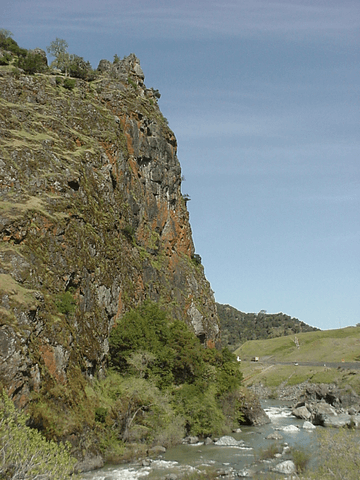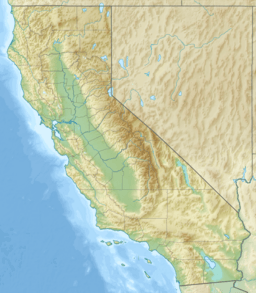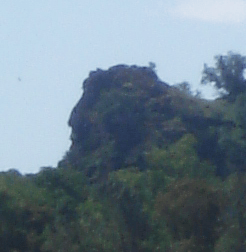Frog Woman Rock facts for kids
Quick facts for kids Frog Woman Rock |
|
|---|---|

Frog Woman Rock as seen northbound on US highway 101
|
|
| Highest point | |
| Elevation | 879 ft (268 m) |
| Geography | |
| Location | Mendocino County, California |
| Topo map | USGS Hopland |
| Reference #: | 549 |
Frog Woman Rock is a unique, tall rock formation in Mendocino County, California. It's a volcanic monolith, which means it's a single, large rock made from volcanic activity. This special landmark is found in the Russian River canyon, right next to U.S. Route 101. It's a popular spot for exciting activities like rock climbing and whitewater kayaking.
Contents
What is Frog Woman Rock?
Frog Woman Rock is a very old and strong rock formation. It stands tall in the Russian River canyon. The river flows right next to it. This rock is a California Historical Landmark. It's known for its interesting shape and the fun outdoor activities it offers.
How Was Frog Woman Rock Formed?
The Russian River flows through a special type of rock called the Franciscan Assemblage. The river's path is pushed against Frog Woman Rock by a slow-moving landslide called Squaw Rock Slide. This landslide forms the east bank of the river. Frog Woman Rock's steep cliffs form the west bank.
Large boulders from the landslide fall into the river. The fast-moving river carries away smaller pieces of dirt and rock. The boulders that stay behind create exciting rapids. These rapids can be tricky, from Class III in summer to Class V during heavy winter rains.
The History of Frog Woman Rock
The Russian River canyon has always been an important path. People used it to travel between the farming areas of Ukiah Valley and the seaports near San Francisco Bay. In 1889, a railroad tunnel was built through Frog Woman Rock. This tunnel, called Northwestern Pacific Railroad tunnel number 8, helped trains travel up the west side of the canyon.
Old wagon roads on the east side of the canyon were later improved. They became part of U.S. Route 101. If you travel south on Highway 101, you might notice that the upper part of Frog Woman Rock looks like a face. Some people think it looks like a person, while others think it looks like a frog.
Legends and Stories
The rock was once known as Squaw Rock. This name came from old stories. One legend, from 1880, is about a young chief named Cachow. He promised to marry Sotuka, a maiden from the Sanel tribe in Hopland. But Cachow married another woman instead.
The legend says that Sotuka was very sad. She found the newlyweds sleeping near the rock. Holding a large stone, she jumped from the cliff. This sad story led to the rock being called "Lover's Leap."
Another story was published in 1891. It tells of a young woman named Pancha. Her mother was a Native American woman, and her father was a Russian from Fort Ross. Pancha fell in love with a gold prospector. He later died, and people thought a man named Concho was responsible. Pancha was heartbroken and fell from the cliff. People later said that when rocks fell from the cliff, it was Pancha's spirit throwing stones.
In 1956, Squaw Rock became California Historical Landmark number 549. The description was based on the "Lover's Leap" story.
Why the Name Changed
Researchers found old notes from the late 1800s by John Hudson. He was a doctor and studied the Pomo tribes of the area. His notes showed that the Pomo people had their own name for the rock.
In the Northern Pomo language, the rock was called "Bi-tsin’ ma-ca Ka-be’." This means "frog woman cliff." The notes described "Bi-tsin’ ma-ca" as a "frog woman." She was an important figure in Pomo traditional beliefs. She was often seen as the clever wife of Coyote, a trickster character in many Pomo stories. Pomo people avoided the rock because they believed Frog Woman lived there.
Later research in 1985 confirmed this. A Pomo speaker said that in the Central Pomo dialect, "Squaw Rock" was called "kawao maatha qhabe," which also means "Frog Woman Rock."
The word "squaw" is now seen as offensive by many modern Native Americans. It originally meant "woman" in some eastern Native American languages. However, over time, it was used in a disrespectful way. Because of this, and to honor the Pomo people's heritage, the name was changed.
In 2011, the State Office of Historic Preservation officially changed the landmark's name to "Frog Woman Rock." This change respects the cultural history of the Pomo people in the region.
Fun Activities at Frog Woman Rock
Frog Woman Rock is a great place for outdoor adventures!
Whitewater Kayaking and Rafting
The Russian River drops quickly near Frog Woman Rock. This creates exciting rapids. These rapids are popular for kayaking all year. During winter and spring, when the water is higher, you might even be able to go rafting. However, these rapids are considered the most challenging on the Russian River. They are not suitable for canoes.
Rock Climbing and Bouldering
The large rocks next to the river offer fun bouldering challenges. Bouldering is a type of rock climbing done on smaller rocks without ropes. The climbs here range from easy to more difficult. To reach these climbing spots, you usually need to wade through water that can be waist-deep. It's best to go during the summer or early fall when the river's water level is low.



